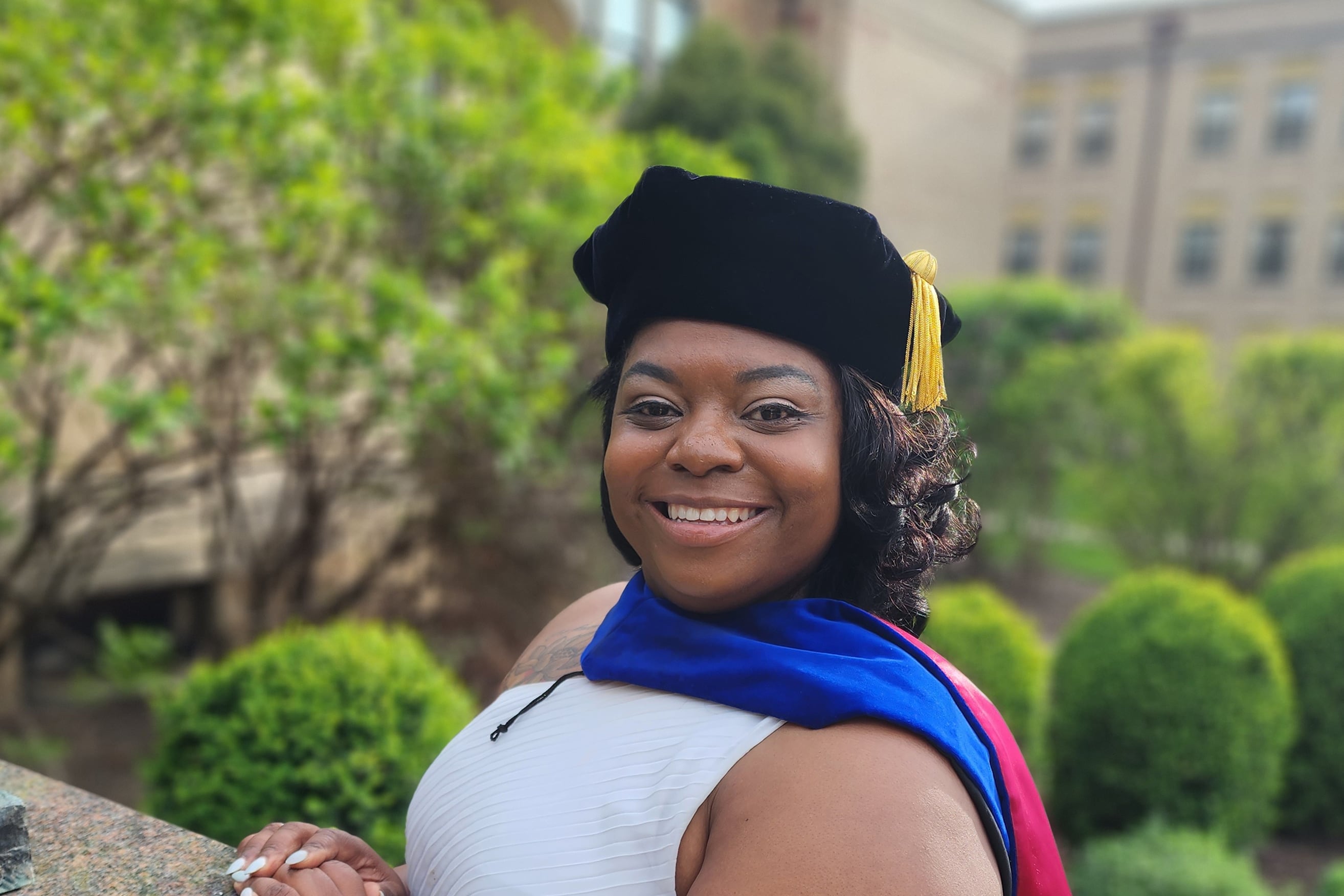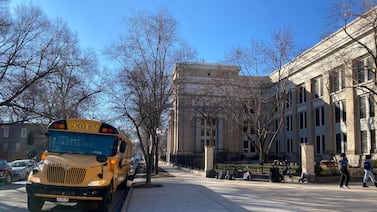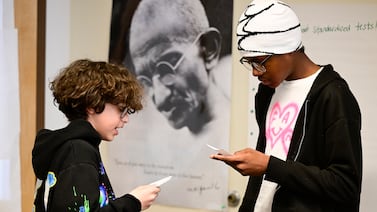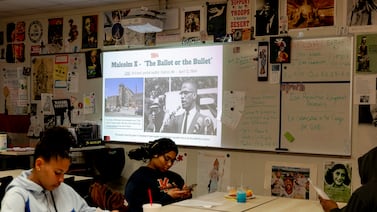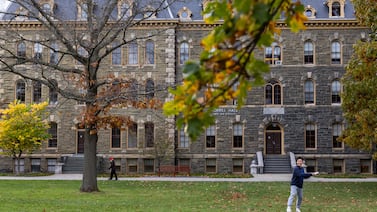Marlita Ingram was an English teacher at Chicago’s Manley Career Academy High School in the early 2000s when she realized that she wanted to be a school counselor.
She noticed that students who struggled in class were often dealing with a problem outside of school. She learned that if she built a relationship with them, then they would sometimes open up.
Ingram, who has been a counselor for the past 18 years, helps students work through a range of problems – from issues with their class schedule to dealing with gun violence, which recently claimed the lives of four students near three Chicago schools.
Even as a seasoned educator, Ingram, a department chair at Foreman College and Career Academy High School, is still learning new ways to connect with students. Recently, as the school has welcomed many new migrant students, Ingram has relied on Google Translate, bilingual staff, and trusted friends of her Spanish-speaking students to facilitate conversations.
“I’ve had kids who are not even on my caseload [say], ‘Can I talk to you?’ I’m like, ‘OK, yeah, baby, you can talk to me,’ and it’s because one of their friends brought them,” she said. “The more approachable you are … I think they gravitate, and they are willing to tell you more than what you want to know, but they’ll tell you what they have on their mind.”
This interview has been lightly edited for length and clarity.
Was there a moment when you decided to become a counselor?
Outside the classroom, I was doing a lot more community-based work with my students. They needed help with navigating different things in the community. They were having issues at home with family, and I started engaging with that work. And then one summer, I kinda helped out the school counselor at the school, and I was like, “I think this is what I want to do.” I still always tell people my passion or my niche is to teach or to help educate. I just do it in a different way with school counseling.
How do you get to know your students?
It varies. Kids say my presence is always “automatic” when I come in the room because I’m very boisterous. I’m very alive when I’m doing class instructions or class lessons with students. But I’m also a person who notices the small things.
If it’s a student I’ve never known before and they’re on my caseload, I might do a general introduction via email. We can see kids’ pictures; I just do a random look at the pictures so that I can start putting names and faces together. If I start seeing them in the hallway, I’m just like, “Hi, I’m Dr. Ingram, your counselor. What’s your name again?” I start that very general conversation, and then I build from there.
I try to be in the hallway during passing periods so I can observe how kids are interacting with each other. Do I see anything that’s not positive – bullying or something like that? I stay away from being security because that’s more punitive, and that’s not my role. But you will hear me in the hallway be like, “Ay!” Especially if it’s one of my kids that I’ve known for a while [like], “Uh-uh, Joshua, you already know where you’re supposed to be. I know your schedule by heart.” I don’t, but they think I do.
Every interaction builds to the next interaction. I’m in the middle of programming, so we sit one-on-one with our kids, and we start having conversations, like, “So what do you want to do? … Let’s start seeing where we need to plug in classes that might fit well with what you think you may want to do, and you can change your mind.” Kids flock to you when they know that you care.
Over the past month, multiple students in Chicago have been fatally shot near school, causing a lot of grief for not just the families, but also for students and staff. What are the first steps you take to support students experiencing grief?
On a school level, we may do some acknowledgment. We have these two groups, right, that don’t necessarily live by each other. They live in certain pockets of the city. One of our African American students may have heard about something in that particular area, whereas my Latino students may not know because they don’t live in that area. It’s sometimes challenging to be able to finagle what’s happened in what community, but when we do have that information, we do offer crisis services for students here at the school with our social workers. We have great outside partners, with Youth Guidance, with BAM and WOW. They chime in and help as much as needed. On a daily basis, in the counseling suite, we have a wellness room. It’s a space for students to utilize to kind of regulate their emotions. [One student was] dealing with the loss of her father. That was her saving grace when she transitioned back into school.
And then we are starting to help teachers get more involved in the regulation because sometimes kids won’t come to us. So we’re in the process [of] ordering different things that kind of help create a space, that if a kid just wants to take a timeout, and they don’t want to come all the way down to the counseling office, teachers can have these chair corners already established in their room that have gadgets and fidgets, meditating things, some breathing exercises, coloring, all the different things that can kind of help a student regulate and refocus.
What’s something happening in the community that affects what goes on inside your school?
We have [had an] increase in one part of the community of robberies. I’ve got a couple of kids who have been stuck up for shoes, jackets.
[Separately], we have an influx of our migrants that are coming in. Our bilingual numbers have doubled. So learning how to communicate with the students and make them feel welcome and safe.
I have learned over the years a few phrases, but I cannot hold a complete conversation in Spanish, but I utilize Google Translate. [Students learning English] become very resourceful, and they’ll find a peer partner to help translate. We have a list of staff that are bilingual or trilingual that I can reach out to like, “Hey, can you translate for me real quick?” especially with a parent and or a student. So we just try to maneuver, and I’m still trying to learn Spanish because I think I should just learn it anyway.
Tell us about a memorable time — good or bad — when contact with a student’s family changed your perspective or approach.
I had a student who didn’t know how to come out to his family. That transition was a very hard time for him. And this was early on in my career. It was the first time I had a student who came out to me, right? And the love and support that I saw from [his mother and aunt]. It really, truly made me understand the need for that full circle, for that student to be that courageous, to be able to say, “This is who I am, and this is why you know. I’m not going to hide it anymore.” So it made me very much more in tune to try and check to see if I had any biases, and if I did, to try to correct those to be a support.
What part of your job is most difficult?
The meetings. As leaders in the building, we are pulled into quite a few meetings, and balancing that with being available for students in need [is a challenge]. Our leadership, our administration, only allows students to see us during the lunch period. (If a kid is in crisis, it doesn’t matter when it is.) But trying to balance being a presence, providing our perspective, being in leadership roles in the building, and being available to students — sometimes that just totally throws off your day. I’ll have days where I’ve been in meetings most of the day and I feel like I haven’t been available for my students. I’m learning as a department chair that sometimes your impact may be indirect because you’re making decisions … that are going to affect students indirectly. So I’m servicing them, it’s just not the direct service. And my passion is the direct service, right?
The second part is student advocacy. If I’m advocating for a student, be it for an academic issue or social-emotional or something like that, that is part of my job. It sometimes makes that tension [with another teacher or administrator] a little strong, I’m gonna say. [Teachers] feel as though I’m taking the kid’s side — I’m not.
What was the biggest misconception that you initially brought to teaching?
In teaching, my biggest misconception was that I thought all kids wanted to learn. I figured, if you came to school, you want to be there. That’s not how it is. We got kids who come for other reasons. It took me a while to learn that. I believe that a lot of students come to school for socialization. That doesn’t mean that we don’t have kids who want to learn — that’s not what I’m saying. But I am saying, kids feed off of interacting with their peers and growing those relationships.
As a counselor, I think my misconception was that I would have more freedom and fluidity throughout my day, and I really don’t. It’s very structured. Like [people will say], “Oh, you don’t have a class, so what are you doing?” When I walked in the door, it’s literally boom, boom, boom, boom, boom, sneak in a lunch, boom, boom.
What’s the best advice you’ve received?
With school counseling, the best advice was for me to be transparent to students and families, to be vulnerable. If I can show them I was OK being transparent and I was comfortable being vulnerable with them, then they would do the same. If we can have that baseline of vulnerability and respect, we can go wherever we needed to go.


